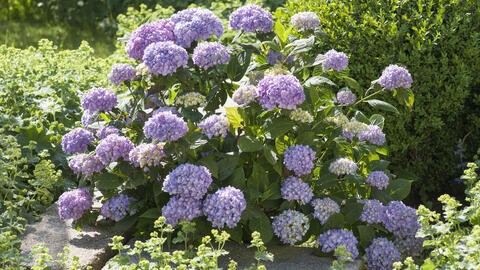Hydrangea care: The 3 Most Common Mistakes
Be it cutting, watering or fertilizing: Avoid these mistakes whenever possible to keep your hydrangeas healthy and blooming vigorously in summer.

Hydrangeas require gentle care: If you cut back Bigleaf Hydrangeas too much, you may have to do without the flowers for a year
With their impressive blue, pink or white flowers, Hydrangeas are among the most popular ornamental shrubs in the garden. Even if the location and the soil are well chosen: Mistakes in care can quickly lead the hydrangeas to stop blooming. If you implement the following tips, you can enjoy beautiful flowers for a long time.
The most common mistake is probably made when pruning the hydrangeas in early spring. If you cut Bigleaf hydrangeas (Hydrangea macrophylla) - with the exception of Endless Summer hydrangeas - and mountain hydrangeas (Hydrangea serrata) too much, the flowers are usually irretrievably lost. Because for these species the following applies: Flower buds for the new season start forming in late summer or fall of the previous year. Only old inflorescences and frozen shoots fall out at the end of February. The situation is different for panicled hydrangea (Hydrangea paniculata) and Smooth Hydrangeas (Hydrangea arborescens): They only bloom on the new wood. With them, all shoots can be cut back to short stumps with one pair of eyes each in late fall or early spring. Do not wait too long before pruning, so that the beginning of flowering does not move too far into late summer.
The botanical name is same as the common name: Humid environment is a must for the "water jugs". In their natural environment, the shallow-roots grow in moist deciduous forests on loose, lime-poor soils - in our garden, too, they love evenly moist soil, which does not become too damp. Pay particular attention to regular watering in the first few days after planting the hydrangeas and in the summer months. If the leaves of the flowering shrubs hang in the midday heat, this indicates that they need more water - possibly even twice a day. But do not water with tap water, because this is usually too hard and can lead to chlorosis. Rainwater or softened drinking water is best - Hydrangeas in pots.

In addition to the water requirement, the nutritional requirements of strong uptakers should not be underestimated. Similar to the Rhododendron, they prefer an acidic, humus-rich soil. Therefore, not every agent is optimally suited for fertilizing the hydrangeas: Common garden compost, for example, can slightly raise the pH of the soil. Instead, experts swear by well-deposited cattle manure or cattle manure pellets, which are mixed into the upper soil layer in a ring around the well-grown hydrangeas in fall or spring. Alternatively, you can feed the flowering shrubs in spring with a special, acidic hydrangea or rhododendron fertilizer. It is essential that you observe the manufacturer's instructions on dosage. From the end of July hydrangeas no longer need to be fertilized. Otherwise it can happen that the shoots no longer fully mature and the winter hardiness of the shrubs decreases.
By the way: An alum solution is often used to color hydrangea flowers blue. However, it only achieves the desired effect with certain pink varieties of the Bigleaf hydrangea.
